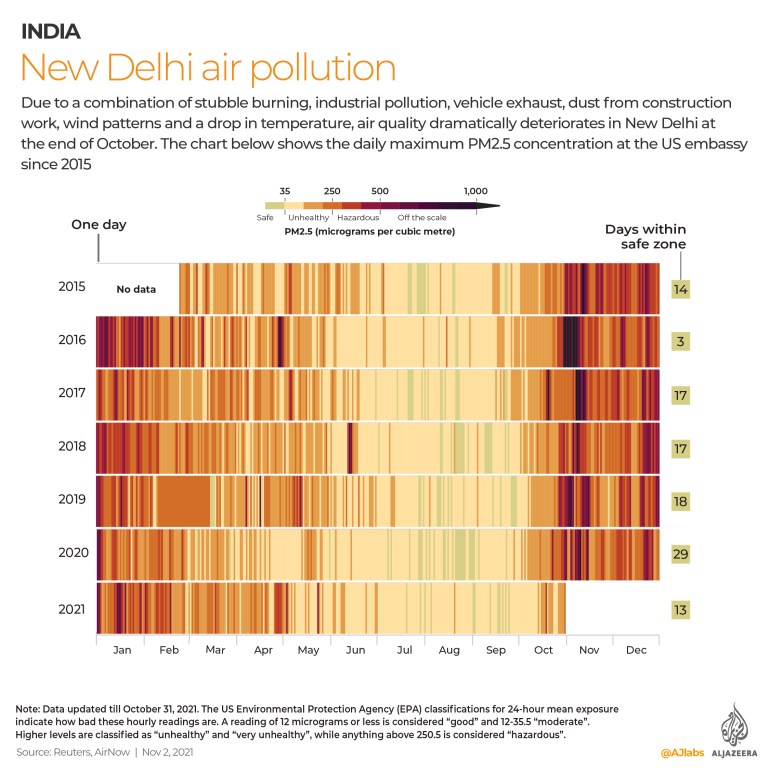After rare clean spell, air quality set to drop in Indian capital
Falling temperatures and farmers preparing to torch farm waste are likely to once again turn the air in New Delhi hazardous.

Favourable weather conditions led to a rare drop in pollution in India’s capital New Delhi, with residents last month breathing the cleanest air in at least four years but the authorities are warning that air quality is set to drop sharply in November.
A delayed end to the monsoon, intermittent rains and a sharp pick-up in wind speeds ensured that the concentration of hazardous, very small airborne particulate materials, known as PM2.5, in a cubic metre of air averaged 72 in October when air quality typically takes a turn for the worse.
Keep reading
list of 4 itemsNew Delhi opens first ‘smog tower’; expert says ‘absolute waste’
‘I smell it, taste it, feel its heaviness’: Life in Delhi’s dust
Delhi’s pollution and a rise in COVID-19 infections
That was sharply down from an average concentration of 126 recorded in October 2020 – 25 times over the World Health Organization’s safe limit – according to data gathered by the state-run Central Pollution Control Board.
But a confluence of factors, including falling temperatures, a drop-off in winter wind speed and farmers preparing to torch farm waste of the previous rice crop to ready the field for planting the wheat crop, is likely to turn the air hazardous.

“Because of frequent rains, most farmers didn’t get to burn crop stubble, and now they have an even shorter window to dispose of crop waste,” said Anumita Roychowdhury, an executive director at the Centre for Science and Environment think-tank.
“As rains ebb, more and more farmers will rush to burn rice stubble, and that will happen when broader weather patterns will allow pollutants to hang in the air, resulting in a thick smog,” Roychowdhury said.
Adding to the concerns, the Diwali festival of lights falls on Thursday when Indians will set off firecrackers as part of an ancient Hindu tradition.
Delhi has banned the sale of firecrackers, but authorities rarely get to enforce such curbs.

“The October air was clean, but we’re really worried about November,” said a senior government official involved in framing policies to curb air pollution. “Stubble burning could peak right after Diwali.”
Crop waste burning accounts for about a quarter of air pollution in October and November.
Residents divided over Modi’s net zero pledge
Poor air quality over the capital is a reminder of the challenges India faces in reducing pollution as world leaders meet at the United Nations COP26 summit in Glasgow, Scotland to agree on strategies to fight global warming.
On Monday, India’s Prime Minister Narendra Modi said his country would aim to stop adding greenhouse gases to the atmosphere by 2070 – 20 years after the United States and at least 10 years later than China pledged to do so.
Modi said the goal of reaching “net zero” by 2070 was one of five measures India planned to undertake to meet its commitments under the Paris climate accord.

Jitender Saxena, 47, who works in a shop and is an ardent supporter of Modi, said he will not be surprised if India achieves the goal much earlier than 2070.
“Today, anywhere that Modi goes, the whole world is looking up to him,” he said.
Others however said individuals will have to take more initiative in achieving the goal.
“The prime minister or any political party says many things, but it depends on the people,” said 23-year-old Damiya Farhana, a postgraduate student from the northeastern Assam state.
Abdul Hai, a 43-year-old unemployed graphic designer, said the only way to save the environment was to stop dependence and usage of “modern things and technologies”.